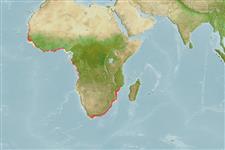>
Mugiliformes (Mullets) >
Mugilidae (Mullets)
Etymology: Chelon: Greek, chelone = turtle (Ref. 45335).
Eponymy: Auguste Henri André Duméril (1812–1870), was a physician and zoologist like his father (see next entry) and followed much in his father’s footsteps. [...] (Ref. 128868), visit book page.
More on author: Steindachner.
Issue
Genetic data indicate that Chelon dumerilii is a complex of two species, one from Northwest and West central African coasts (= C. dumerilii), one in southeastern African coasts (Refs. 114224, 123262).
Environment: milieu / climate zone / depth range / distribution range
Ecologia
marinhas; Água doce; estuarina demersal; catádromo (Ref. 51243). Tropical; 20°C - 25°C (Ref. 13614); 21°N - 36°S, 20°W - 38°E
Eastern Atlantic: Mauritania to South Africa (Ref. 3573, 57400). Western Indian Ocean: Delagoa Bay, Mozambique to Mossel Bay, South Africa (Ref. 81659).
Comprimento de primeira maturação / Tamanho / Peso / Idade
Maturity: Lm 17.0 range ? - ? cm
Max length : 40.0 cm TL macho/indeterminado; (Ref. 4393); common length : 18.0 cm SL macho/indeterminado; (Ref. 7399)
Espinhos dorsais (total) : 5; Raios dorsais (total) : 8 - 9; Espinhos anais: 3; Raios anais : 8 - 9. Diagnosis: 8-9 anal soft rays; anal fin and lower lobe of caudal fin whitish or greyish (Ref. 57400). Body with ctenoid scales except for anterior predorsal scales which are cycloid and extend to anterior nostril or slightly beyond (Ref. 81659). Scales numerous (Ref. 57400), not large, 33-41 in a longitudinal series (excluding scales on caudal fin base), 11-14 scale rows between pelvic and first dorsal fin (Ref. 81659). 5-8 mucous canals on scales in front of 1st dorsal fin (only 1, less often 2 or 3, in other Liza species (Ref. 57400). Posterior end of maxilla sigmoid, curved down over premaxilla; serrate, anteroventral edge of lachrymal distinctly concave; pharyngobranchial organ with 1-2 valves, anteroventral valve a moderate size, semi-lunate flap, posterior valve usually vestigial, as a small nodule or, at most, a low papillate fold, and may be absent (Ref. 81659).
Inhabit shallow coastal waters (Ref. 27121), including estuaries (Ref. 2683, 57400, 81659), lagoons (Ref. 57400), tidal rivers (Ref. 3573), freshwater and supersaline environments (Ref. 81659). Feed on plankton and detritus (Ref. 28587). Oviparous, eggs are pelagic and non-adhesive (Ref. 205). Shows a remarkable adaptation to hyperhaline environments (up to 97‰ in the Sine Saloum in Senegal)(Ref. 57400). Specimens from tropical East Atlantic reaching maximum of 280 mm SL and common to 180 mm SL (Ref. 81659).
Ciclo de vida ou comportamento de acasalamento
Maturidade | Reprodução | Desova | Ovos | Fecundidade | Larvas
Thomson, J.M., 1990. Mugilidae. p. 855-859. In J.C. Quero, J.C. Hureau, C. Karrer, A. Post and L. Saldanha (eds.) Check-list of the fishes of the eastern tropical Atlantic (CLOFETA). JNICT, Lisbon; SEI, Paris; and UNESCO, Paris. Vol. 2. (Ref. 7399)
Status na Lista Vermelha da UICN (Ref. 130435: Version 2024-2)
Ameaça para os humanos
Harmless
Uso pelos humanos
Pescarias: espécies comerciais
Ferramentas
Relatórios especiais
Baixar XML
Fontes da internet
Estimates based on models
Preferred temperature (Ref.
123201): 19.6 - 27.9, mean 26.1 °C (based on 96 cells).
Índice de diversidade filogenética (Ref.
82804): PD
50 = 0.5005 [Uniqueness, from 0.5 = low to 2.0 = high].
Bayesian length-weight: a=0.01288 (0.00835 - 0.01988), b=2.99 (2.87 - 3.11), in cm total length, based on LWR estimates for this species & Genus-body shape (Ref.
93245).
Nível Trófico (Ref.
69278): 2.7 ±0.32 se; based on food items.
Generation time: 2.6 ( na - na) years. Estimated as median ln(3)/K based on 2
growth studies.
Resiliência (Ref.
120179): Elevada, tempo mínimo de duplicação da população menor que 15 meses (Preliminary K or Fecundity.).
Fishing Vulnerability (Ref.
59153): Low to moderate vulnerability (26 of 100).
Nutrients (Ref.
124155): Calcium = 98.3 [27.6, 541.6] mg/100g; Iron = 0.84 [0.43, 1.47] mg/100g; Protein = 17.8 [16.4, 19.3] %; Omega3 = 0.487 [0.210, 1.143] g/100g; Selenium = 17 [7, 41] μg/100g; VitaminA = 14 [4, 41] μg/100g; Zinc = 0.934 [0.591, 1.443] mg/100g (wet weight);
